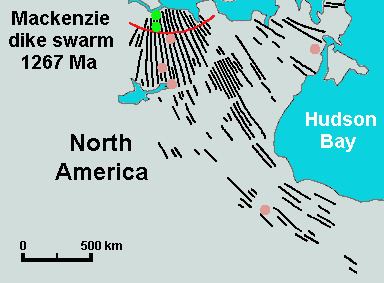 | ||
The Mackenzie dike swarm, also called the Mackenzie dikes, form a large igneous province in the western Canadian Shield of Canada. It is part of the larger Mackenzie Large Igneous Province and is one of more than three dozen dike swarms in various parts of the Canadian Shield.
Contents
The Mackenzie dike swarm is the largest dike swarm known on Earth, more than 500 km (310 mi) wide and 3,000 km (1,900 mi) long, extending in a northwesterly direction across the whole of Canada from the Arctic to the Great Lakes. The mafic dikes cut Archean and Proterozoic rocks, including those in the Athabasca Basin in Saskatchewan, Thelon Basin in Nunavut and the Baker Lake Basin in the Northwest Territories.
Coppermine River Group
Vast volumes of basaltic lava paved over a large area in the western Canadian Shield in the form of a flood basalt event. This massive eruptive event occurred during the Mesoproterozoic era about 1,267 million years ago. Today the thickness of these flood basalts range from 2,000 m (6,600 ft) to 3,500 m (11,500 ft) and consists of about 150 lava flows, each about 10 m (33 ft) to 25 m (82 ft) thick, which are part of the Copper Creek Formation.
Except for the lowermost lava flows, which contain evidence of interaction with water, the entire sequence was erupted subaerially. Eruption of plateau lavas near the Coppermine River built an extensive volcanic plateau about 1,200 million years ago with an area of about 170,000 km3 (40,785 cu mi), representing a volume of lavas of at least 500,000 km3 (119,956 cu mi). This basalt sequence has been called the Coppermine River Group and may have been contemporaneous with the Mackenzie dikes and with the Muskox intrusion.
Origin and history
The source for the Mackenzie dike swarm is considered to be a mantle plume center called the Mackenzie hotspot. About 1,268 million years ago, the Slave craton was partly uplifted and intruded by the giant Mackenzie dike swarm. This was the last major event to affect the core of the Slave craton, although later on some younger mafic magmatism registered along its edges.
